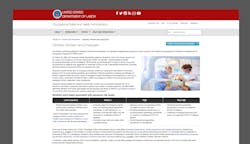New OSHA guidance on COVID-19 released, triggering liability risks for reopened practices
On Friday, the Occupational Safety and Health Administration (OSHA) issued a new guidance for dentistry workers and employers related to the COVID-19 pandemic.1 The dental guidance falls under OSHA's general interim guidance, which requires employers to provide their employees safety from SARS-CoV-2, the virus strain that causes COVID-19.
Of note, the guidance explicitly states that OSHA aligns with the current Centers for Disease Control and Prevention (CDC) recommendation that only emergency patients should be seen at this time. The guidance reads: "Only patients needing urgent and emergency procedures should be seen during the pandemic. Consistent with CDC recommendations, all elective dental procedures should be postponed. Limiting services to urgent or emergency treatment will help control dental workers' possible exposure to sick patients."i [Editor's note: Links are as they appear on the OSHA website.]
The guidance raises legal concerns for practices that have chosen to reopen for elective dental procedures. Practices may be assuming risk and be liable should a patient or employee contract SARS-CoV-2 in the dental setting. Both CDC and OSHA recommendations inform medical and employee law, and state dental boards also use their recommendations in oversight decisions.
As of May 5, 2020, 21 states have allowed dental practices to reopen for elective procedures.2
The guidance also updates exposure risk levels for dental providers:
- Performing aerosol-generating procedures on known or suspected COVID-19 patients is classified as "very high risk."
- Among tasks that are considered "high risk" are aerosol-generating procedures on well patients, which would include certain dental hygiene procedures outside of hand scaling.
Personal protective equipment recommendations in the guidance note that National Institute for Occupational Safety and Health–certified N95 respirators or better should be used for well patients undergoing aerosol-generating procedures.
The full guidance from OSHA may be found here: COVID-19 - Control and Prevention / Dentistry Workers and Employers.
Note
i. At the time of publication, CDC recommendations were last updated April 27, 2020.
References
- COVID-19 - Control and Prevention / Dentistry Workers and Employers. Occupational Safety and Health Administration. Published May 1, 2020. Accessed May 5, 2020. https://www.osha.gov/SLTC/covid-19/dentistry.html
- American Dental Association Center for Professional Success. COVID-19 State Mandates and Recommendations. Updated May 5, 2020. Accessed May 5, 2020. https://success.ada.org/en/practice-management/patients/covid-19-state-mandates-and-recommendations
Zachary Kulsrud is the group editorial director for Endeavor Business Media's dental group, publishers of Dental Economics, DentistryIQ, Perio-Implant Advisory, and RDH magazine.
Related
- CDC updates reopening guidance for dental settings (Published April 28, 2020)
- American Dental Hygienists' Association issues Interim Guidance on Returning to Work (Published May 3, 2020)
- New ADA HPI research brief projects 66.5% reduction in dental spending for 2020 (Published May 4, 2020)
Editor's note: This article first appeared in the Morning Briefing, a daily newsletter published by Dental Economics, DentistryIQ, Perio-Implant Advisory, and RDH. Learn more and subscribe here.
For full coverage of the coronavirus pandemic, visit the DentistryIQ COVID-19 Resource Center.
About the Author

Zachary Kulsrud
Zachary Kulsrud is the editorial director for Endeavor Business Media's dental group, publishers of Dental Economics, DentistryIQ, Perio-Implant Advisory, and RDH magazine.
Updated July 7, 2020
